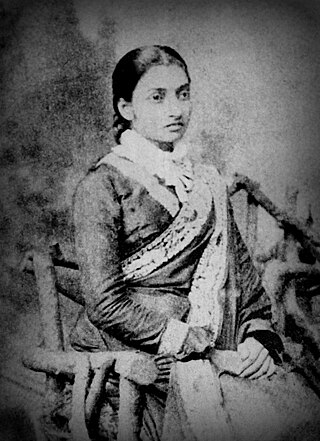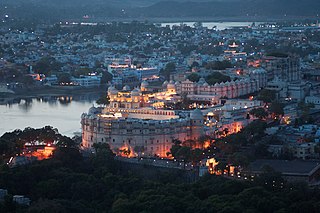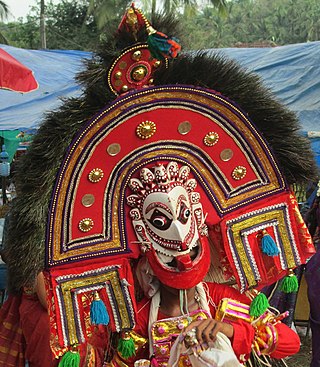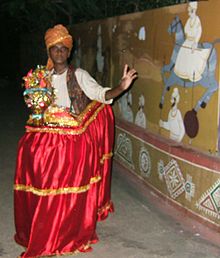
A sari is a women's garment from the Indian subcontinent. It consists of an un-stitched stretch of woven fabric arranged over the body as a robe, with one end attached to the waist, while the other end rests over one shoulder as a stole, sometimes baring a part of the midriff. It may vary from 4.1 to 8.2 metres in length, and 60 to 120 centimetres in breadth, and is a form of ethnic wear in India, Sri Lanka, Nepal, Bangladesh, and Pakistan. There are various names and styles of sari manufacture and draping, the most common being the Nivi style. The sari is worn with a fitted bodice also called a choli and a petticoat called ghagra, parkar, or ul-pavadai. It remains fashionable in the Indian subcontinent today.

The Bihu dance is an indigenous folk dance from the Indian state of Assam related to the Bihu festival and an important part of Assamese culture. Performed in a group, the Bihu dancers are usually young men and women, and the dancing style is characterized by brisk steps and rapid hand movements. The traditional costume of dancers is centered around the red color theme, signifying joy and vigour.
Clothing in India varies with the different ethnicities, geography, climate, and cultural traditions of the people of each region of India. Historically, clothing has evolved from simple garments like kaupina, langota, achkan, lungi, sari, to perform rituals and dances. In urban areas, western clothing is common and uniformly worn by people of all social levels. India also has a great diversity in terms of weaves, fibers, colors, and the material of clothing. Sometimes, color codes are followed in clothing based on the religion and ritual concerned. The clothing in India also encompasses a wide variety of Indian embroidery, prints, handwork, embellishments, and styles of wearing clothes. A wide mix of Indian traditional clothing and western styles can be seen in India.

A pantomime horse is a theatrical representation of a horse or other quadruped by two actors in a single costume who cooperate and synchronize their movements. One actor plays the front end, including the horse's head and its front legs, in a more-or-less upright posture and with a reasonable field of view afforded by eye holes in the horse's head. The other actor, playing the rear end of the animal, must bend at the waist so that their torso is horizontal like that of a horse and put his arms around the waist of the first actor. They can see little, although there are normally eye holes in the bottom part of the horse's torso to enable them to see where they are putting their feet and to enable them to breathe.
Fatehpur is a city in the Sikar district of Indian state Rajasthan. It is part of the Shekhawati region. It is midway between Sikar city and Bikaner on National Highway 52. It is also the land to Havelis built by Marwari Seth's. It also has many Kuldevi Temples of the Agarwal community for Bajoria,Bindal, Saraf, Chamadia, Choudhary, Goenka, Lohia, Singhania, Saraogi, Bhartia Families. It is famous for its extreme weather conditions throughout the year. In winters, the minimum temperature falls below 0 °C at night for many days making it the coldest town in India in non mountainous region. In summer the temperature rises to 50 °C in the afternoon making it one of the hottest places in India. 1985 Bollywood film Ghulami starting Dharmendra, Naseeruddin Shah, Mithun Chakraborty and Smita Patil was extensively shot here in many of its havelis and the railway station.

Udaipur is a city in the north-western Indian state of Rajasthan, about 415 km (258 mi) south of the state capital Jaipur. It serves as the administrative headquarters of Udaipur district. It is the historic capital of the kingdom of Mewar in the former Rajputana Agency. It was founded in 1559 by Udai Singh II of the Sisodia clan of Rajputs, when he shifted his capital from the city of Chittorgarh to Udaipur after Chittorgarh was besieged by Akbar. It remained as the capital city till 1818 when it became a British princely state, and thereafter the Mewar province became a part of Rajasthan when India gained independence in 1947. It is also known as the City of Lakes, as it is surrounded by five major artificial lakes.
Gair dance is one of the popular, famous folk dances from Rajasthan in India which is mostly performed by the Bhil community but found in all over Rajasthan.

The Kalbelia are a snake charming tribe from the Thar Desert in Rajasthan, India. The dance is an integral part of their culture and performed by men and women.
Various dance forms are practiced in Tamil Nadu, the southernmost state of India. Tamil Nadu is the home of the Tamil people, who speak Tamil language, one of the oldest surviving languages in India. With archaeological evidence pointing to the Tamilakam region being inhabited for more than 3,800 years, Tamil culture has seen multiple influences over the years and has developed diversely. With its diverse culture, many forms of individual and group dances have their origins in the region.

Ghagra choli is a type of ethnic clothing for women from the India, notably in the Indian states of Rajasthan, Gujarat, Madhya Pradesh, Uttar Pradesh, Bihar, Haryana, Punjab, Himachal Pradesh, Uttarakhand, Jammu and Kashmir. In Punjab, the lehenga is traditionally worn with a kurti. It is a combination of the ‘’ghagra or lehenga and the choli (blouse). In contemporary and modern usage lehenga choli is the widely used term by fashion designers, trend setters, and boutiques in India, since ghagra is synonymous with the half-slip (petticoat) worn as an undergarment below the sari.

The Kaashtha sari is a Koli style of sari draping very similar to the way the Maharashtrian dhoti is worn. The word Kaashtha refers to the sari being tucked at the back. Since this sari is usually worn by using a single nine yard cloth, it is also referred to as Nauvari, which means Nine Yards. Sakachcha sari is another term commonly used to refer to this style of sari. It is referred to as Akanda Vastra, which means it doesn't need any other attire to support it. In fact, this attire holds utmost importance as women across different walks of life have worn it. It is not just worn at religious and cultural events, but women have fought wars in the past and still work in farmlands wearing this.

Aati Kalenja is an ancient traditional folk art form practiced by Tulu people from the region of Tulu Nadu, India which is believed to bring prosperity during Aati which is one of the months in Tulu calendar. It normally comes in the months of July and August.

In folklore, a hobby horse is a costumed character that features in some traditional seasonal customs, processions and similar observances around the world. In England, they are particularly associated with May Day celebrations, mummers' plays and the Morris dance.

Gotipua is a traditional dance form in the state of Odisha, India, and the precursor of Odissi classical dance. It has been performed in Orissa for centuries by young boys, who dress as women to praise Jagannath and Krishna. The dance is executed by a group of boys who perform acrobatic figures inspired by the life of Radha and Krishna. The boys begin to learn the dance at an early age until adolescence, when their androgynous appearance changes. In the Odia language, Gotipua means "single boy" (goti-pua). Raghurajpur, Odisha is a historic village known for its Gotipua dance troupes. The dance of the Gotipuas is accompanied by traditional Odissi music with the primary percussion being the Mardala.

Folk dance of Mexico, commonly known as baile folklorico or Mexican ballet folk dance, is a term used to collectively describe traditional Mexican folk dances. Ballet folklórico is not just one type of dance; it encompasses each region's traditional dance that has been influenced by their local folklore and has been entwined with ballet characteristics to be made into a theatrical production. Each dance represents a different region in Mexico illustrated through their different zapateado, footwork, having differing stomps or heel toe points, and choreography that imitates animals from their region such as horses, iguanas, and vultures.
The following are the special concepts and terminology of belly dance. As this dance has many forms and can be found in North Africa and the Middle East, a significant proportion of the terminology is in Arabic. Turkish or Turkish-loan words may also be encountered among belly dance terms.
Chang dance is a folk dance from Rajasthan, India. It is also referred to Dhamal, dhuff dance,, and as Holi dance as it is performed during the Hindu festival of the same name (Holi) to celebrate the defeat of evil. It is a group dance performed by men, carousing and singing riotously to the rhythmic beat of the chang instrument.

Poikkaal Kuthirai Aattam or Puravi Aattam is one of the folk dances of Tamil Nadu. It is a type of dance performed with a dummy horse having a gap inside so that a person can fit into it to perform the dance.

Poothamkali is folk art form in the state of Kerala, India. This art form uses various types of decorations in the costume. It is usually performs in the Bhagavathy temples of Malappuram district. It is based on the myth of Durga and her combat with Darika.















